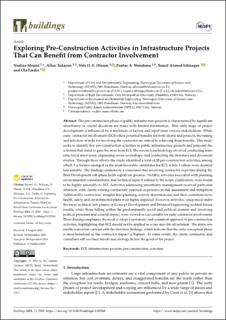| dc.description.abstract | The pre-construction phase of public infrastructure projects is characterized by significant uncertainty as crucial decisions are made with limited information. This early stage of project development is influenced by a multitude of factors and input from various stakeholders. While early contractor involvement (ECI) offers potential benefits for both clients and projects, the timing and selection of tasks for involving the contractor are critical to achieving these benefits. This study seeks to identify key pre-construction activities in public infrastructure projects and pinpoint the activities that stand to gain the most from ECI. The research methodology involved conducting semi-structured interviews, organizing seven workshops, and conducting the literature and document studies. Through these efforts, the study identified a total of 20 pre-construction activities, among which 5 activities emerged as the most favorable candidates for ECI, while 5 others were deemed less suitable. The findings underscore a consensus that involving contractor expertise during the Brief Development sub-phase holds significant promise. Notably, activities associated with planning, environmental considerations, and technical aspects related to the scope clarification, were found to be highly amenable to ECI. Activities addressing uncertainty management received particular attention, with clients valuing contractors’ practical experience in risk assessment and mitigation. Additionally, contractors’ insights into planning, activity dependencies, and their contributions to health, safety, and environmental plans were highly regarded. However, activities, categorized under the more technical sub-phases of Concept Development and Detailed Engineering yielded mixed results, while those falling within the predominantly social and political domain and involving political processes and societal impact, were viewed as less suitable for early contractor involvement. These findings emphasize the need to adopt a systematic and consistent approach to pre-construction activities, highlighting that ECI should not be applied as a one-size-fits-all solution. The interview results somewhat contrast with the literature findings, which indicate that the early conceptual phase is most beneficial as the contractor impact is highest. To some extent, the client, contractor, and consultant still see their benefit and strategy before the good of the project. | en_US |

